Termite inspection Brisbane Can Save You Money:
Termite inspection Brisbane service can save a homeowner a lot of stress and frustration. Termites can obviously do a lot of damage to a home. But it’s not until it happens to yours that the reality rings true.
I get to do termite inspections all over Brisbane and I see some pretty bad damage caused by termites.
The homeowner goes through mixed emotions when they first realise that they have a termite issue in their home.
Most people make the mistake of dismantling the termite workings which of course is a huge mistake.
I see this big mistake all the time during a termite inspection Brisbane service. The most beneficial thing to do before touching anything is; call the experts.
It seems homeowners just aren’t getting the message of exactly what they should do when they find termites.
As you can see from the photos, this customer did the wrong thing, by pulling down the wall and disturbing the colony.
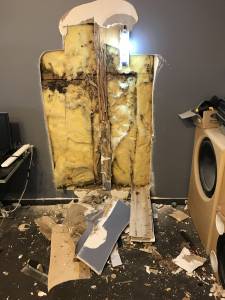


Never Disturb Termites
I write these blogs in the hope that it better educates the general public about the do’s and don’ts of termites.
As you can see from the pictures the damage caused by termites can be very extensive. Not only is there the cost of the termite company, but also the repairs.
This property will need a colony control treatment to get rid of the termites. Then a full termite barrier treatment will have to be installed around the home.
A termite inspection Brisbane service every 12 months can help to reduce the risk of termites. An inspection is the most important thing a homeowner can do to protect their home from termite attack.
Tools Needed For A Termite Inspection:
The tools needed to properly complete a non-invasive termite inspection Brisbane are as follows.
Now, this list is long, but the tools within it are essential aids in detecting termites in and around the home.
- Binoculars
- Compass
- Knife
- Ladder
- Magnifying Glass
- Moisture Meter
- Powerful Torch
- Sounding Device
- Stepladder
- Screwdriver
- Personal Protection Equipment
- Tape Measure
Now lets me just say there are some tools on this list that some people may think are useless. But they all have a purpose and the three most important are the “Moisture Meter” “Thermal Imaging Camera” “Sounding Device”
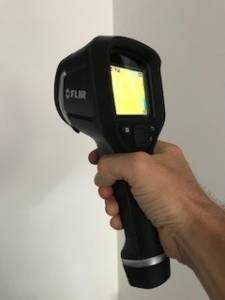

Thermal Imaging Camera
Tools like the screwdriver and knife are mainly used for prying open pieces of wood suspected to have active termites.
The binoculars are used to look up high standing trees in a garden. And then the tape measure is obvious I would think. Personal protection equipment keeps us safe.
The sounding device is a plastic ball on the end of what looks like a golf stick. This tool helps us to sound out whether a piece of timber such as skirting boards is hollow. This can be an indication of possible active termites.
The moisture meter is probably the most important tool to use. This will give an accurate reading of moisture content behind a wall. Where moisture is located this could mean there are active termites present.
Moisture behind wall panels can also be an indication of a leaking pipe in the wall cavity. Leaking pipes in walls will make the timber moist and this will certainly attract termites.
The tool that I like to use the most is the thermal imaging camera. This tool will give good detail of what is inside a wall by showing variances in temperature. Some people are under the impression that a thermal imaging camera can see through the wall when this is not the case.
The way a thermal image is made is the camera will pick up the different temperatures of the wall coverings and then the studs behind it. It then makes an image out of this and the image is displayed on the screen.
The photos to the right are of the same area in a bedroom, but one is taken with the thermal imaging on, and one without.
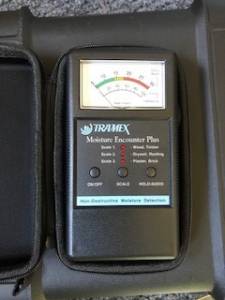

Moisture meter for inspecting a home for termites
What’s In A Termite Inspection Report?
The reporting is one area that a lot of termite inspectors dislike, this is because it can be very time-consuming.
To write a well-detailed termite report takes about 30 minutes to an hour depending on what is found during the inspection.
I personally prefer to use an electronic report they are much more details and can be emailed to the client.
Some pest controllers write their reports at the house after the inspection. I find this is too rushed and prefer to be more thorough, but that’s just my opinion.
In my opinion, a termite inspection Brisbane report is meant to give the customer a clear idea of the risk their house may be at to termite attack.
It’s not just about finding termites; this is obviously a big part of reporting. But it should also outline any other issues a house has that may be conducive to future termite attack.
The report will give details of the Day and time of the inspection. Areas that are conducive to termite attack both inside and outside of the property. Give details of any active termites found in the house or the surrounding gardens. It will also show areas found where there is high moisture; and will also have a detailed sketch of the house and any other buildings.
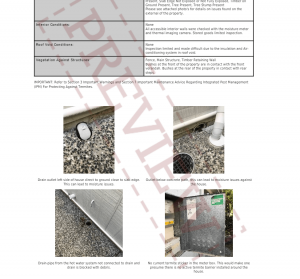

What A Report Looks Like
Inspecting The Roof Void & Sub-Floor:
The roof void and sub-floor areas are places where termites can easily gain concealed access to a home.
They must be inspected during a termite inspection Brisbane process as stated by the AS 3660.2.2017.
An inspector doesn’t have to go into either the roof void or the sub-floor of a house if certain conditions restrict them.
Roof void restrictions are if the man-hole access cover is not big enough for the inspector to fit through safely. Or if the height of the manhole cover is above 3.6 meters. Or if there is any kind of foil insulation within the roof void. And where there is limited crawl space within the roof void.
The same criteria apply to access to a sub-floor, with exception to the high obviously
Where there is limited or restricted access to a roof void or sub-floor the reason must be stated in the report. The As 3660.2.2017 is a standard set out that all termite inspectors must abide by.
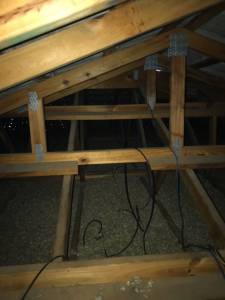

The Worst Termite Species In Brisbane:
Identifying a termite species is an important part of a termite inspection Brisbane procedure. Depending on the species will depend on the type of treatment to be carried out.
The worst termite in Australia is Mastotermes darwiniensis. But we don’t need to worry about them because they aren’t found here in Brisbane.
The two main species that are found in homes in Brisbane are Coptotermes and Schedorhinotermes. Between them, they cause more damage to Brisbane homes than any other.
The species shown in the photo to the right is Coptotermes which is the most destructive termite in Brisbane.
When either of these two termite species is found during a termite inspection Brisbane they need to be dealt with carefully.
If termites are incorrectly treated within a home, they can very easily pop-up at a later time in a different location within the home.
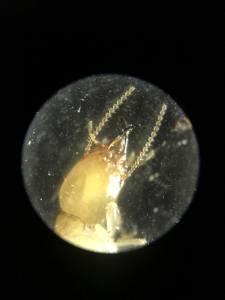

Coptotermes
DIY Termite Inspections:
During a termite inspection, there are a number of things that a pest control technician is looking for. It’s a bit like being a detective and now you get to play the role of a detective during your DIY inspection.
This is one for the avid DIYer of the house, I know we all like to try our hand at DIY from time to time. But termite inspections are probably not the best place to be starting your DIY career.
For those of you that are brave enough to give it a go, I would like to give you some pointers. At least this way you may have a better understanding of what you are doing.
What to look for during your DIY termite inspection. Start in the garden and you want to be looking for mounds on the ground in garden beds or that are close to your property.
The mounds will look like the one in the photo on the right. Also, look through garden mulch as some species such as Schedorhinotermes will build nests there.
Inside look for cupping in walls and tap around window sills and door frames especially in wet areas. Where cupping or warping in a wall is present it could be signs of a termite nest.
Inside wooden houses like Queenslanders look and listen out for lose or damaged floorboards. This again could be signs of termites.
Go up into the roof void and look for unusual shapes on framing timbers, but be careful not to fall through.
If there is a sub-floor get some overalls on and crawl around checking all of the piers. When checking piers you’re looking for mudding on the outside or termite trail like in the photo to the right.
What I have just mentioned for an inspection is just the same as what a termite inspection Brisbane company would do. But a professional termite inspector has a few more tools at their disposal.
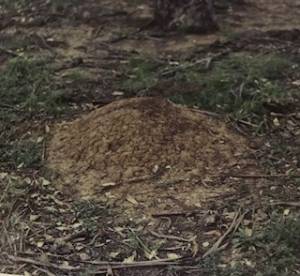

Termite Mound
The tools are as mentioned earlier the moisture meter and the thermal imaging camera. These sorts of inspection tools are just too expensive for a DIYer to invest in.
A DIY termite inspection is not what I recommend but it doesn’t hurt to keep an eye out for termites. Especially if you live in a termite prone area like close to a wooded area.
If at any time you do find termites in your home please call a professional to deal with them.
Do not try a DIY termite treatment this should always be left to a professional. And never disturb or destroy any termite working you find inside or outside your home.
I still recommend having a 12 monthly termite inspection done by a professional. It’s the safest way to ensure termites don’t eat your home.
Do Termites Need Ground Contact:
Brisbane is full of termites they seem to pop up in the most peculiar places like in multi-story buildings in the middle of town.
That’s right termites can even make their way into high-rise buildings. In this situation, they have been known to destroy architraves and skirting boards in units.
Some termite species do not need contact with the ground for moisture. Some people believe that all termites need ground contact, this is not the case.
With a termite species such as Coptotermes they can go without ground contact providing there is a constant water source available.
Coptotermes acinaciformis have been found on timber barges with no contact with the ground. They get their moisture from fresh or salt water that is absorbed through the timber.
Termites are very resilient creatures and will adapt to new environments. Their sole purpose is colony survival, and they are good at it.
Termite Home Insurance:
Many homeowners believe that you cannot get insurance to cover for termite damage to a home. The truth is you can get an insurance policy to 100% cover for all termite damage.
There is a catch to getting the insurance policy. A full termite barrier must be installed around the home by a licensed termite company.
A termite inspection Brisbane company must also carry out a full inspection of the home every 12 months.
If a barrier is installed then the company that installed it can apply on behalf of their client for the insurance policy. The cost of the policy is $420.00 for 5 years and this comes with no excess. This price is current as of the date of this blog.
Once a policy has been submitted the insurer will assess the application and decide whether or not to cover the property.
Sometimes the insurance company may knock back a policy; this is usually if the insurer deems the property at to higher risk.
If you are having a barrier treatment of any kind installed it may be worth asking your termite company about the insurance.



Insurance Would Have Covered This Damage
Conclusion:
I hope this blog has given you some insight into the world of a termite inspection Brisbane process.
As mentioned earlier it is my recommendation to let a professional termite company do your termite inspection.
Sometimes the money saved by trying to do it yourself can cost you lots further down the track.

